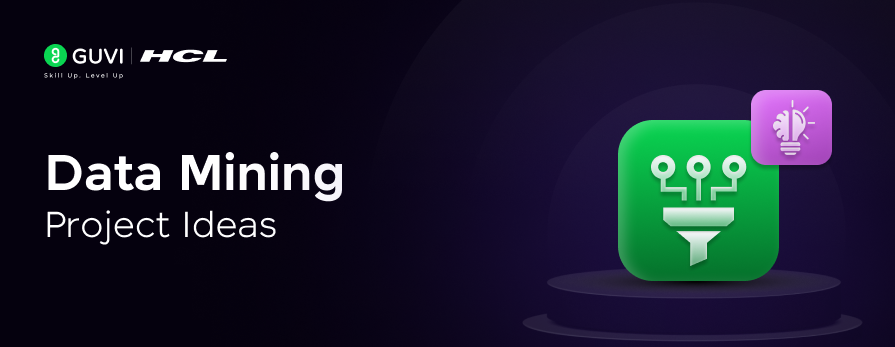
Top 15+ Data Mining Projects with Source Code
Mar 04, 2025 6 Min Read 6955 Views
(Last Updated)
Ever wondered how businesses predict customer preferences or detect fraudulent activities? The magic lies in data mining. In today’s digital landscape, understanding data mining projects has become a gateway to unlocking valuable insights.
Whether you’re a beginner or a seasoned developer, working on real-world data mining project ideas can enhance your skills and make you industry-ready.
In this article, I will be listing the best data mining projects, ranging from simple data mining projects to advanced ones after thorough research. Each project includes source code to help you get started with their development right away.
Table of contents
- The 18 Best Data Mining Project Ideas from Beginner to Expert [With Source Code]
- Housing Price Predictions
- Health Disease Prediction Using Naive Bayes
- Fake Logo Detection System
- Filtering Top-Performing Schools in NYC
- Retail Customer Segmentation
- Twitter Sentiment Analysis
- Predictive Modeling for Agriculture
- Handwritten Digit Recognition
- Anime Recommendation System
- Mushroom Classification Project
- Evaluating and Analyzing Global Terrorism Data
- Image Caption Generator Project
- Heart Disease Prediction
- User Behavior Prediction from Social Media Data
- Movie Recommendation System
- Breast Cancer Detection
- Solar Power Generation Forecaster
- Prediction of Adult Income Based on Census Data
- Final Words
- FAQs
- What are the easy Data Mining project ideas for beginners?
- Why are Data Mining projects important for beginners?
- What skills can beginners learn from Data Mining projects?
- Which Data Mining project is recommended for someone with no prior programming experience?
- How long does it typically take to complete a beginner-level Data Mining project?
The 18 Best Data Mining Project Ideas from Beginner to Expert [With Source Code]
These 18 data mining projects are selected for their practical applications across diverse industries, offering hands-on experience in analyzing complex datasets and uncovering meaningful patterns.
They cater to all skill levels, helping learners build expertise in critical areas such as predictive modeling, pattern recognition, and anomaly detection.
1. Housing Price Predictions
This project employs machine learning techniques to predict housing prices based on factors like location, size, and amenities. Using algorithms such as Linear Regression and Decision Trees, it helps real estate analysts derive insights from historical data and market trends.

- Complexity Level: Beginner
- Technology Stack: Python, Pandas, Scikit-learn, Tableau
- Project Duration: 3-4 weeks
- Learning Outcomes:
- Data preprocessing
- Regression modeling and hyperparameter tuning
- Feature engineering and handling missing values
- Integration with APIs: Real estate API for live data
- Technical Highlights:
- Evaluation Metrics: R² score, Mean Squared Error (MSE).
- Visualization: Correlation heatmaps and price distribution graphs.
- Data Preprocessing: Handles multicollinearity and outliers.
- Deployment Options: Flask, Streamlit
- Source Code: [Link]
2. Health Disease Prediction Using Naive Bayes
Utilizing the Naive Bayes classifier, this project predicts diseases based on patient symptoms. It’s crucial for early diagnosis and enhancing healthcare decision-making, leveraging probabilistic analysis to identify potential ailments.
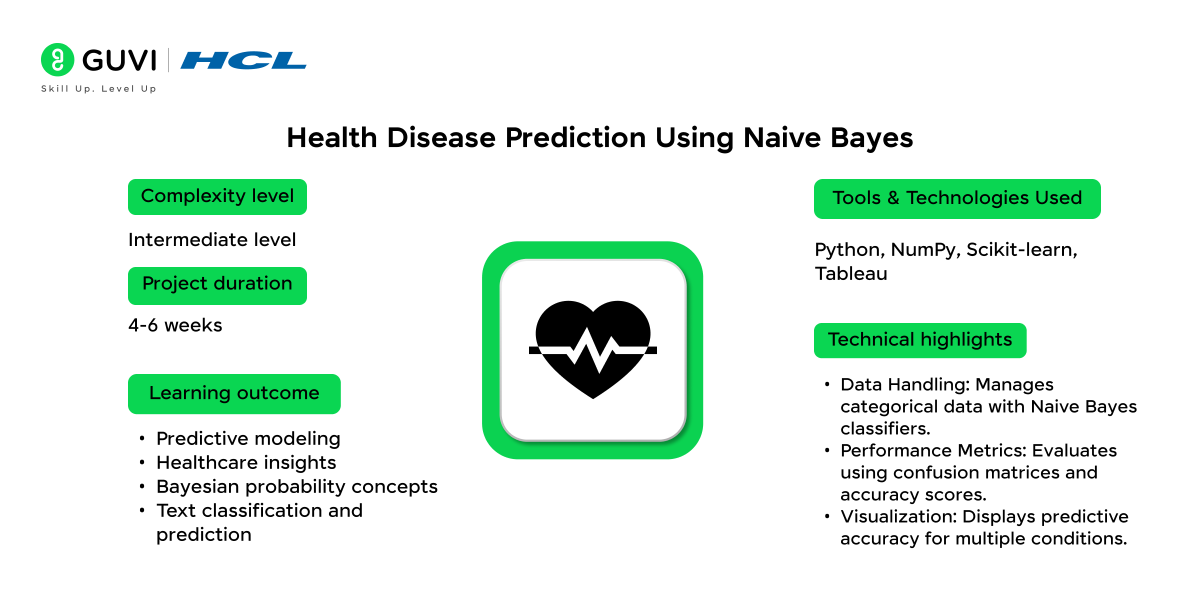
- Complexity Level: Intermediate
- Technology Stack: Python, NumPy, Scikit-learn, Tableau
- Project Duration: 4-6 weeks
- Learning Outcomes:
- Predictive modeling
- Healthcare insights
- Bayesian probability concepts
- Text classification and prediction
- Integration with APIs: Hospital databases
- Technical Highlights:
- Data Handling: Manages categorical data with Naive Bayes classifiers.
- Performance Metrics: Evaluates using confusion matrices and accuracy scores.
- Visualization: Displays predictive accuracy for multiple conditions.
- Deployment Options: Web app, desktop software
- Source Code: [Link]
3. Fake Logo Detection System
A computer vision project that uses convolutional neural networks (CNNs) to detect counterfeit logos in images. This is vital for brand protection, helping businesses identify unauthorized use of their trademarks.
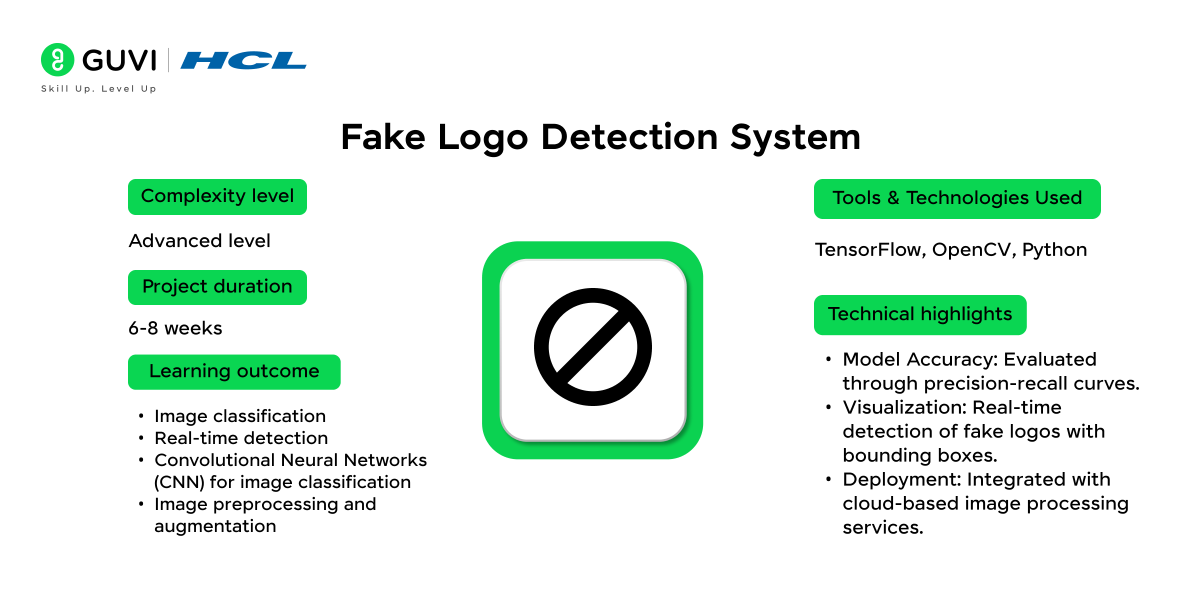
- Complexity Level: Advanced
- Technology Stack: TensorFlow, OpenCV, Python
- Project Duration: 6-8 weeks
- Learning Outcomes:
- Image classification
- Real-time detection
- Convolutional Neural Networks (CNN) for image classification
- Image preprocessing and augmentation
- Integration with APIs: Image upload APIs
- Technical Highlights:
- Model Accuracy: Evaluated through precision-recall curves.
- Visualization: Real-time detection of fake logos with bounding boxes.
- Deployment: Integrated with cloud-based image processing services.
- Deployment Options: Web app
- Source Code: [Link]
4. Filtering Top-Performing Schools in NYC
This project applies data mining to NYC school datasets to evaluate performance metrics such as student scores, teacher effectiveness, and graduation rates. It offers actionable insights for educational policy improvements.
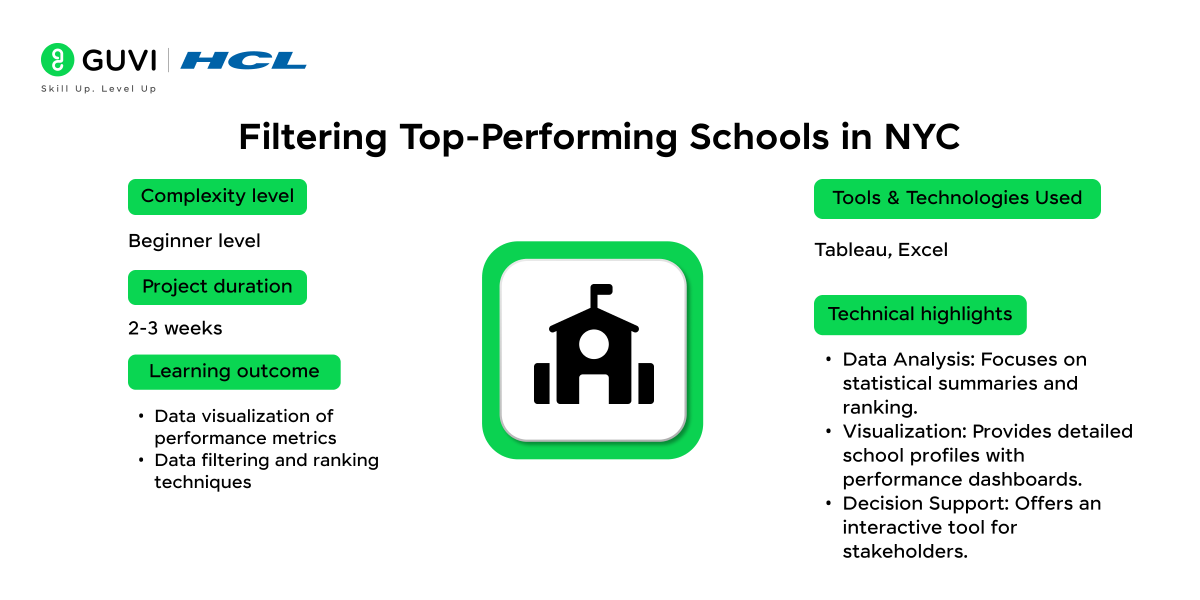
- Complexity Level: Beginner
- Technology Stack: Tableau, Excel
- Project Duration: 2-3 weeks
- Learning Outcomes:
- Data visualization of performance metrics
- Data filtering and ranking techniques
- Integration with APIs: Open NYC education data
- Technical Highlights:
- Data Analysis: Focuses on statistical summaries and ranking.
- Visualization: Provides detailed school profiles with performance dashboards.
- Decision Support: Offers an interactive tool for stakeholders.
- Deployment Options: Tableau Public
- Source Code: [Link]
5. Retail Customer Segmentation
Using clustering algorithms like K-means, this project segments customers based on their purchasing behavior. Businesses can personalize marketing strategies and improve customer retention by understanding distinct consumer groups.
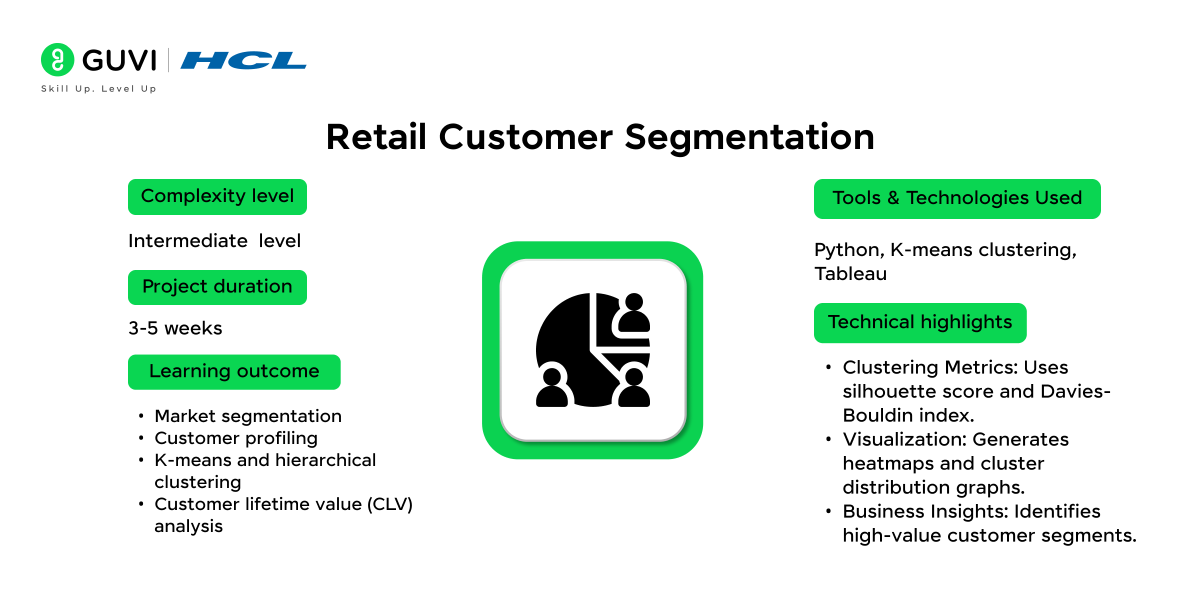
- Complexity Level: Intermediate
- Technology Stack: Python, K-means clustering, Tableau
- Project Duration: 3-5 weeks
- Learning Outcomes:
- Market segmentation
- Customer profiling
- K-means and hierarchical clustering
- Customer lifetime value (CLV) analysis
- Integration with APIs: CRM data integration
- Technical Highlights:
- Clustering Metrics: Uses silhouette score and Davies-Bouldin index.
- Visualization: Generates heatmaps and cluster distribution graphs.
- Business Insights: Identifies high-value customer segments.
- Deployment Options: Tableau Server
- Source Code: [Link]
6. Twitter Sentiment Analysis
Analyze public sentiment on various topics by mining Twitter data. This project uses Natural Language Processing (NLP) techniques to classify tweets as positive, negative, or neutral, aiding in brand reputation management and market analysis.
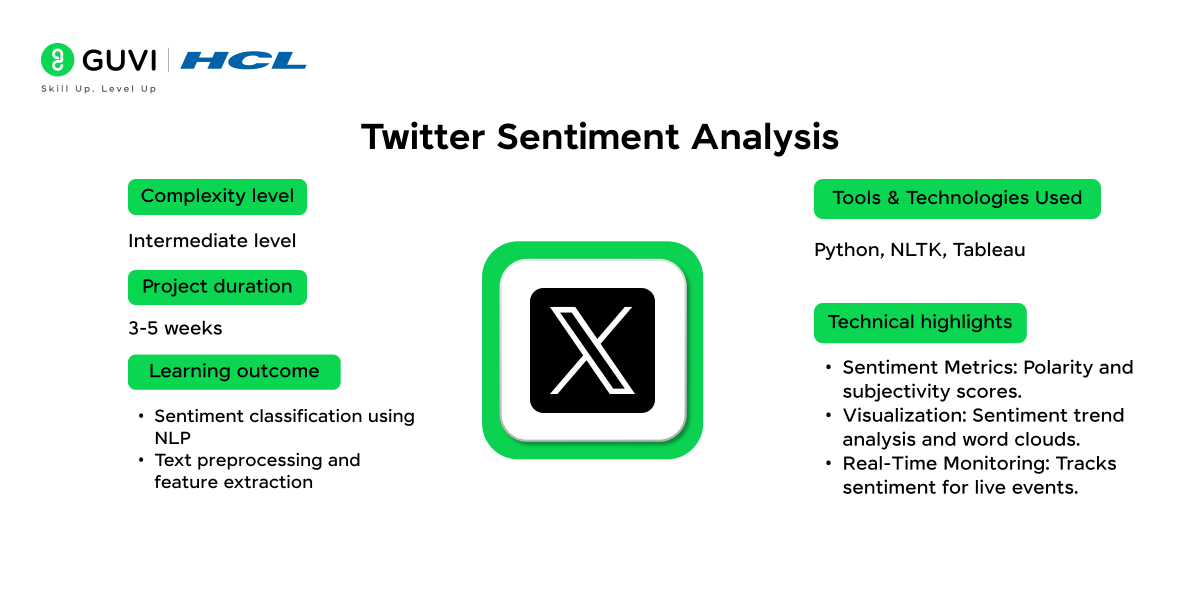
- Complexity Level: Intermediate
- Technology Stack: Python, NLTK, Tableau
- Project Duration: 3-5 weeks
- Learning Outcomes:
- Sentiment classification using NLP
- Text preprocessing and feature extraction
- Integration with APIs: Twitter API
- Technical Highlights:
- Sentiment Metrics: Polarity and subjectivity scores.
- Visualization: Sentiment trend analysis and word clouds.
- Real-Time Monitoring: Tracks sentiment for live events.
- Deployment Options: Streamlit
- Source Code: [Link]
7. Predictive Modeling for Agriculture
This project forecasts crop yields and suggests optimal farming practices using historical weather and soil data. It leverages regression models to improve agricultural productivity and sustainability.
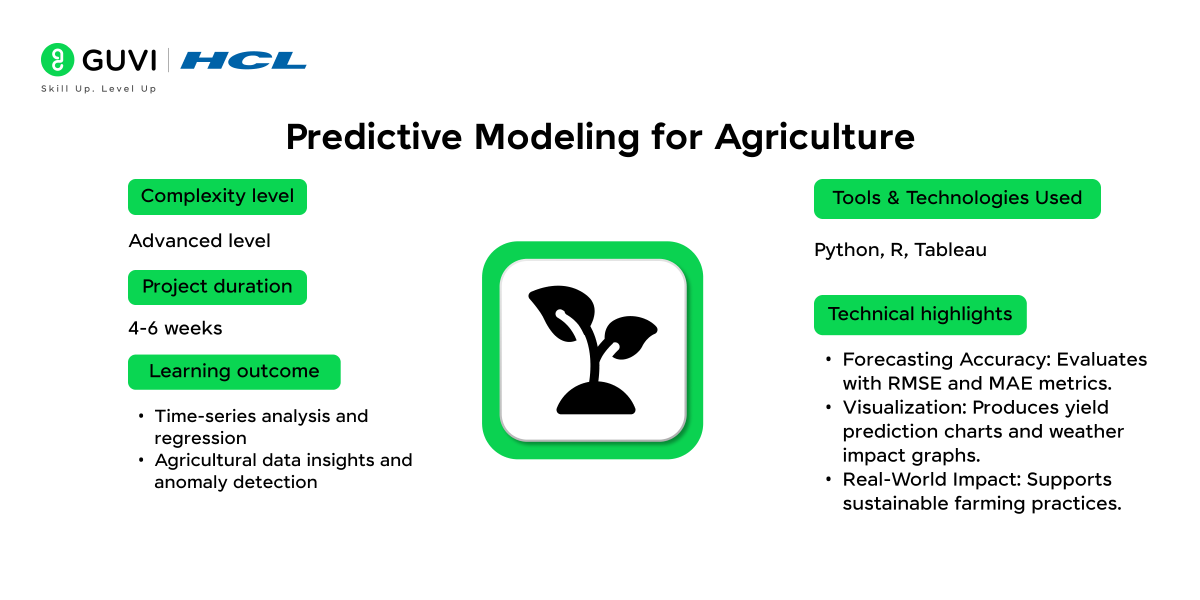
- Complexity Level: Advanced
- Technology Stack: Python, R, Tableau
- Project Duration: 4-6 weeks
- Learning Outcomes:
- Time-series analysis and regression
- Agricultural data insights and anomaly detection
- Integration with APIs: Weather APIs
- Technical Highlights:
- Forecasting Accuracy: Evaluates with RMSE and MAE metrics.
- Visualization: Produces yield prediction charts and weather impact graphs.
- Real-World Impact: Supports sustainable farming practices.
- Deployment Options: Desktop software
- Source Code: [Link]
8. Handwritten Digit Recognition
A classic deep learning project that uses CNNs to classify handwritten digits from the MNIST dataset. It demonstrates how AI can automate tasks like digitizing handwritten documents.

- Complexity Level: Intermediate
- Technology Stack: Python, TensorFlow, Keras
- Project Duration: 4 weeks
- Learning Outcomes:
- CNN architecture and hyperparameter tuning
- Image normalization and model evaluation
- Integration with APIs: Dataset APIs
- Technical Highlights:
- Model Accuracy: Achieves high accuracy (>98%) on test datasets.
- Visualization: Displays misclassified digits and confusion matrix.
- Deployment: Integrates with OCR systems for real-world use.
- Deployment Options: Web app
- Source Code: [Link]
9. Anime Recommendation System
This system uses collaborative filtering and content-based techniques to recommend anime titles based on user preferences. It’s an essential project for understanding recommendation engines, widely used in streaming platforms.

- Complexity Level: Beginner
- Technology Stack: Python, Pandas, Tableau
- Project Duration: 2-3 weeks
- Learning Outcomes:
- Collaborative and content-based filtering
- Recommender system evaluation
- Integration with APIs: Anime data API
- Technical Highlights:
- Evaluation Metrics: Uses precision, recall, and RMSE.
- Visualization: Displays user-anime interaction heatmaps.
- Personalization: Recommends anime based on user preferences.
- Deployment Options: Web app
- Source Code: [Link]
Would you like to build these interesting projects and become a tier-1 data scientist working for top firms? Then, you’ll need proper guided help.
I will advise you to take the best career-oriented approach with updated syllabi, tools, artificial intelligence, and industry-grade projects with GUVI’s Data Science Course hand-crafted by expert data scientists, and master data science as a whole.
10. Mushroom Classification Project
This project categorizes mushrooms as edible or poisonous using decision trees or random forests, based on features like cap shape, color, and habitat. It’s a critical project in the food safety domain.
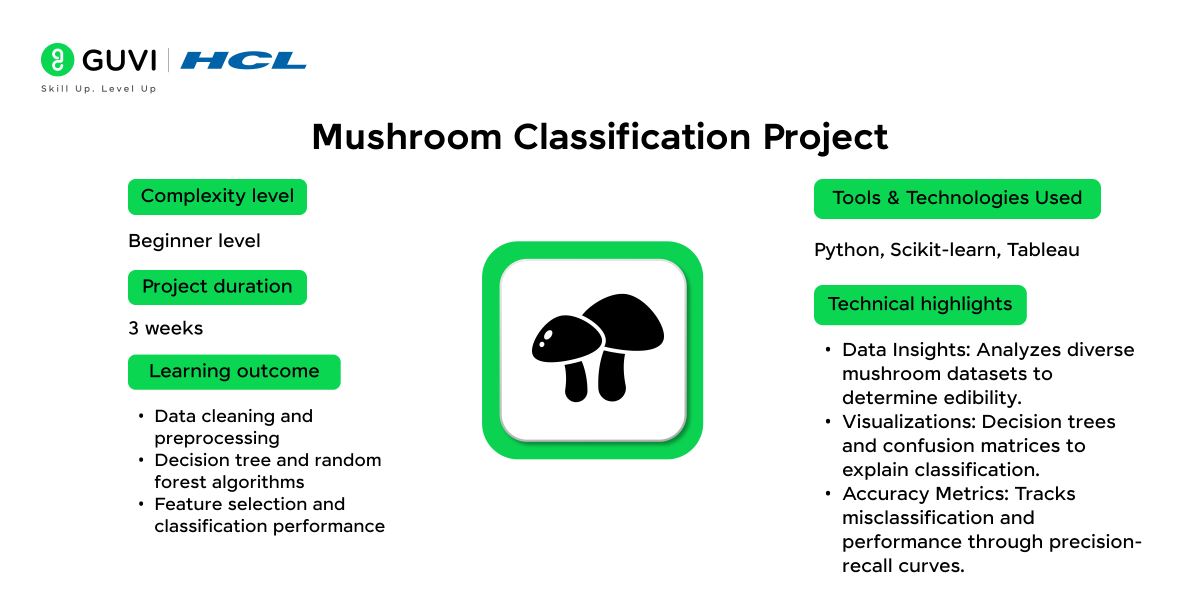
- Complexity Level: Beginner
- Technology Stack: Python, Scikit-learn, Tableau
- Project Duration: 3 weeks
- Learning Outcomes:
- Data cleaning and preprocessing
- Decision tree and random forest algorithms
- Feature selection and classification performance
- Integration with APIs: None
- Technical Highlights:
- Data Insights: Analyzes diverse mushroom datasets to determine edibility.
- Visualizations: Decision trees and confusion matrices to explain classification.
- Accuracy Metrics: Tracks misclassification and performance through precision-recall curves.
- Deployment Options: Local application
- Source Code: [Link]
11. Evaluating and Analyzing Global Terrorism Data
Leverage clustering and visualization techniques to analyze terrorism patterns globally. This project uncovers trends in attack types, regions affected, and timeframes, aiding policymakers in security planning.
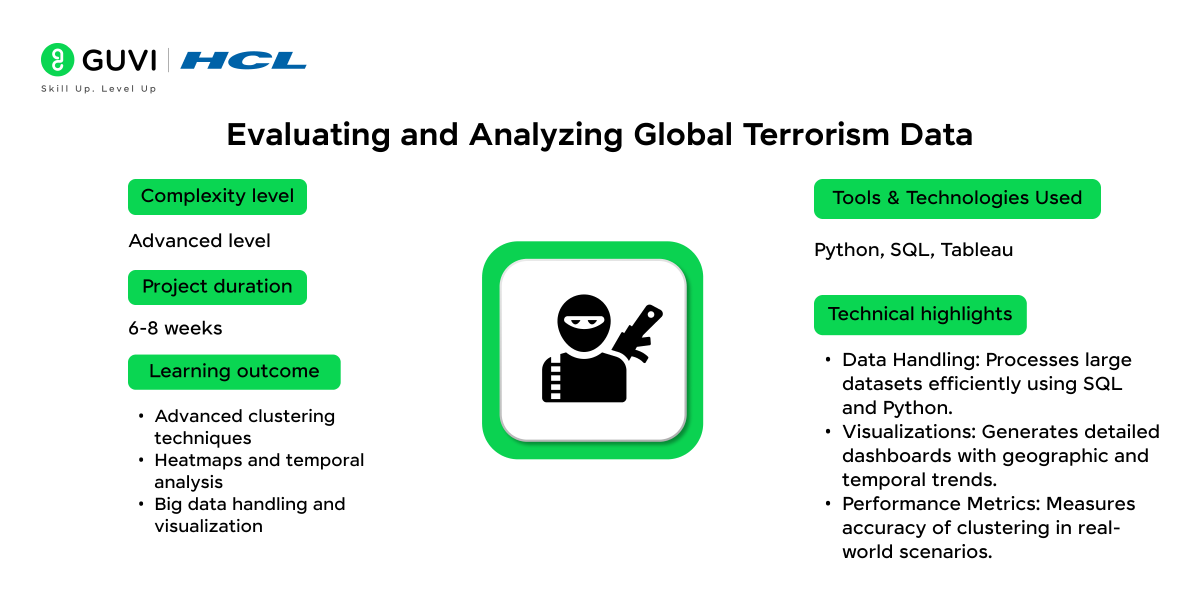
- Complexity Level: Advanced
- Technology Stack: Python, SQL, Tableau
- Project Duration: 6-8 weeks
- Learning Outcomes:
- Advanced clustering techniques
- Heatmaps and temporal analysis
- Big data handling and visualization
- Integration with APIs: Government or open terrorism datasets
- Technical Highlights:
- Data Handling: Processes large datasets efficiently using SQL and Python.
- Visualizations: Generates detailed dashboards with geographic and temporal trends.
- Performance Metrics: Measures accuracy of clustering in real-world scenarios.
- Deployment Options: Tableau Public, SQL databases
- Source Code: [Link]
12. Image Caption Generator Project
Combines CNNs for image feature extraction and RNNs for generating descriptive captions. It’s a complex AI project useful in accessibility tools, enabling automatic image-to-text conversion.
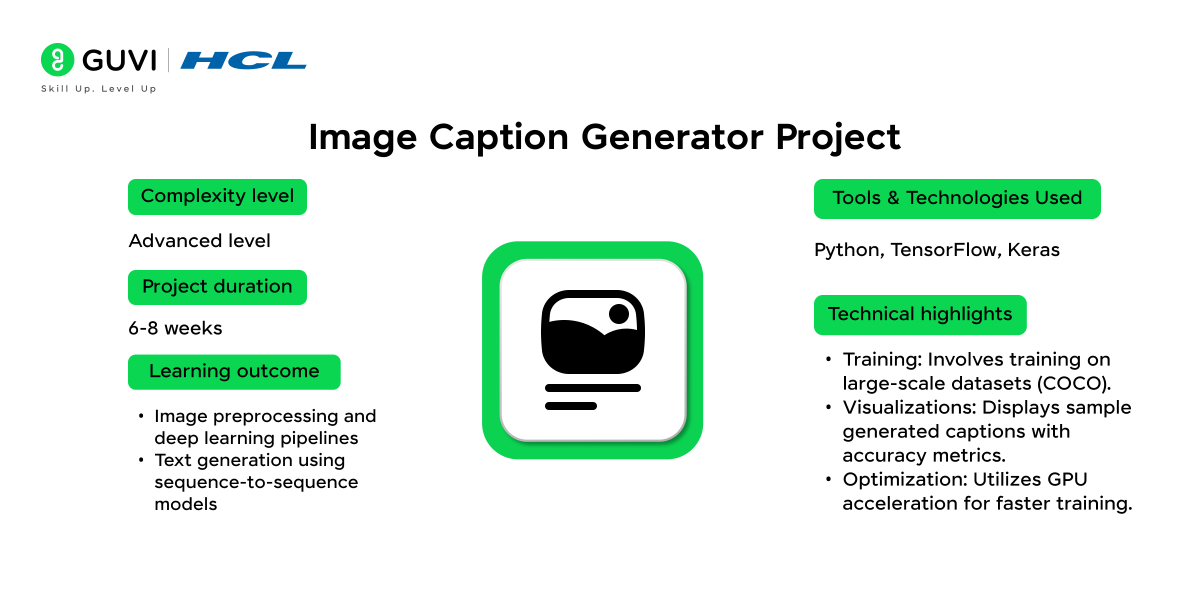
- Complexity Level: Advanced
- Technology Stack: Python, TensorFlow, Keras
- Project Duration: 6-8 weeks
- Learning Outcomes:
- Image preprocessing and deep learning pipelines
- Text generation using sequence-to-sequence models
- Integration with APIs: Image upload APIs
- Technical Highlights:
- Training: Involves training on large-scale datasets (COCO).
- Visualizations: Displays sample generated captions with accuracy metrics.
- Optimization: Utilizes GPU acceleration for faster training.
- Deployment Options: Web or desktop app
- Source Code: [Link]
13. Heart Disease Prediction
This predictive analytics project uses classification models like Support Vector Machines (SVM) to identify patients at risk of heart disease, improving early intervention and resource allocation in healthcare.

- Complexity Level: Intermediate
- Technology Stack: Python, Scikit-learn, Matplotlib
- Project Duration: 4-6 weeks
- Learning Outcomes:
- Feature engineering for healthcare datasets
- ROC and AUC curve analysis
- Integration with APIs: Hospital data systems
- Technical Highlights:
- Visualization Tools: ROC curves, feature importance heatmaps.
- Data Balancing: Addresses class imbalance in health datasets.
- Model Evaluation: Uses F1-score, precision, and recall for performance.
- Deployment Options: Web or desktop applications
- Source Code: [Link]
14. User Behavior Prediction from Social Media Data
By analyzing social media interactions, this project predicts user behaviors such as content preferences and activity patterns. It uses machine learning models to drive targeted marketing and personalized recommendations.
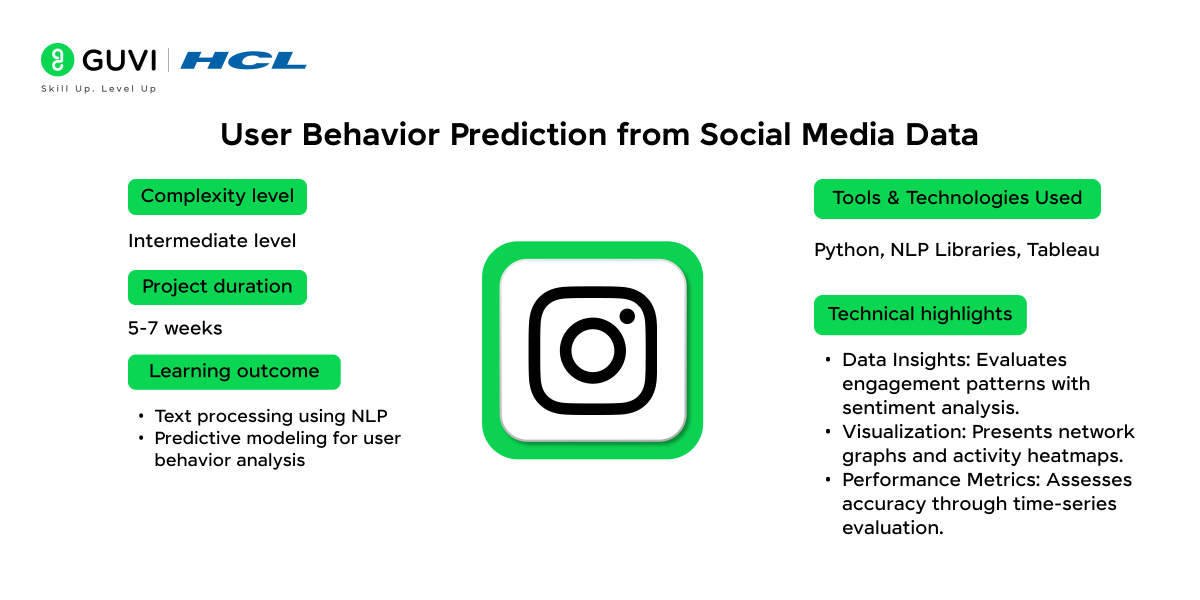
- Complexity Level: Intermediate
- Technology Stack: Python, NLP Libraries, Tableau
- Project Duration: 5-7 weeks
- Learning Outcomes:
- Text processing using NLP
- Predictive modeling for user behavior analysis
- Integration with APIs: Twitter, Facebook Graph API
- Technical Highlights:
- Data Insights: Evaluates engagement patterns with sentiment analysis.
- Visualization: Presents network graphs and activity heatmaps.
- Performance Metrics: Assesses accuracy through time-series evaluation.
- Deployment Options: Web-based dashboard
- Source Code: [Link]
15. Movie Recommendation System
This project builds a recommendation engine that suggests movies based on user history and preferences, using techniques like collaborative filtering. It’s an essential tool for enhancing user experience on streaming platforms.
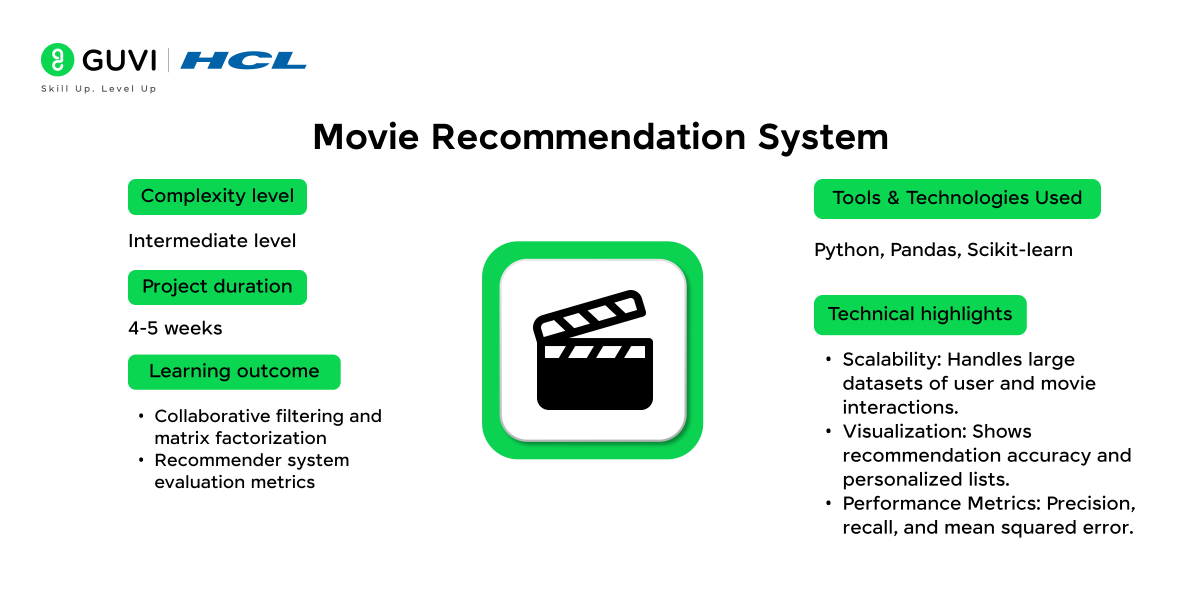
- Complexity Level: Intermediate
- Technology Stack: Python, Pandas, Scikit-learn
- Project Duration: 4-5 weeks
- Learning Outcomes:
- Collaborative filtering and matrix factorization
- Recommender system evaluation metrics
- Integration with APIs: Movie databases (OMDB, TMDb)
- Technical Highlights:
- Scalability: Handles large datasets of user and movie interactions.
- Visualization: Shows recommendation accuracy and personalized lists.
- Performance Metrics: Precision, recall, and mean squared error.
- Deployment Options: Web app
- Source Code: [Link]
16. Breast Cancer Detection
Employing machine learning algorithms like Random Forests or SVM, this project classifies tumor cells as benign or malignant. It aids in early cancer detection, significantly improving patient outcomes.
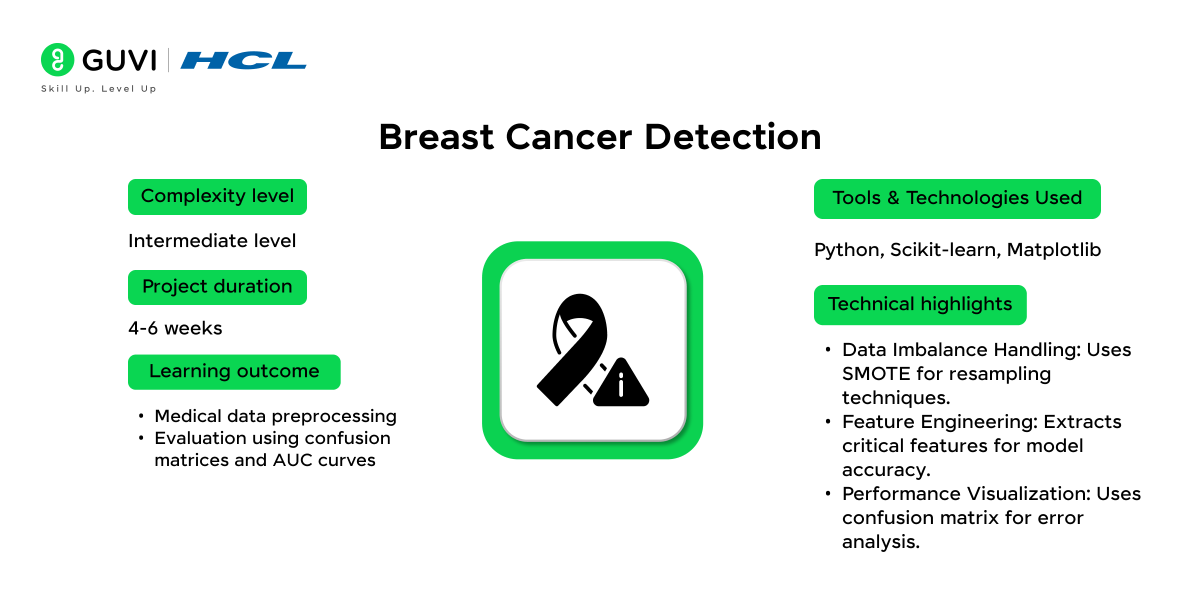
- Complexity Level: Intermediate
- Technology Stack: Python, Scikit-learn, Matplotlib
- Project Duration: 4-6 weeks
- Learning Outcomes:
- Medical data preprocessing
- Evaluation using confusion matrices and AUC curves
- Integration with APIs: Medical databaseS
- Technical Highlights:
- Data Imbalance Handling: Uses SMOTE for resampling techniques.
- Feature Engineering: Extracts critical features for model accuracy.
- Performance Visualization: Uses confusion matrix for error analysis.
- Deployment Options: Desktop or web applications
- Source Code: [Link]
17. Solar Power Generation Forecaster
This project predicts solar energy output based on weather data using regression techniques. It helps in optimizing the use of renewable energy sources and managing power grids effectively.
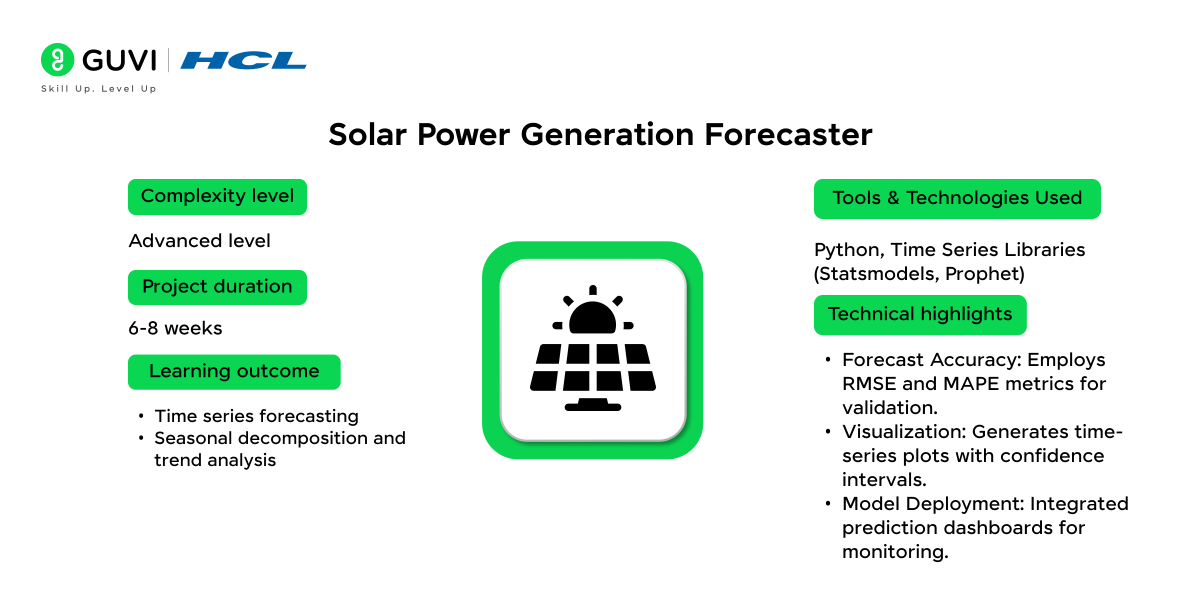
- Complexity Level: Advanced
- Technology Stack: Python, Time Series Libraries (Statsmodels, Prophet)
- Project Duration: 6-8 weeks
- Learning Outcomes:
- Time series forecasting
- Seasonal decomposition and trend analysis
- Integration with APIs: Weather APIs, Solar radiation databases
- Technical Highlights:
- Forecast Accuracy: Employs RMSE and MAPE metrics for validation.
- Visualization: Generates time-series plots with confidence intervals.
- Model Deployment: Integrated prediction dashboards for monitoring.
- Deployment Options: Desktop application
- Source Code: [Link]
18. Prediction of Adult Income Based on Census Data
A classification project that predicts income levels based on demographic and employment data from the census. It provides insights for socioeconomic studies and policymaking.
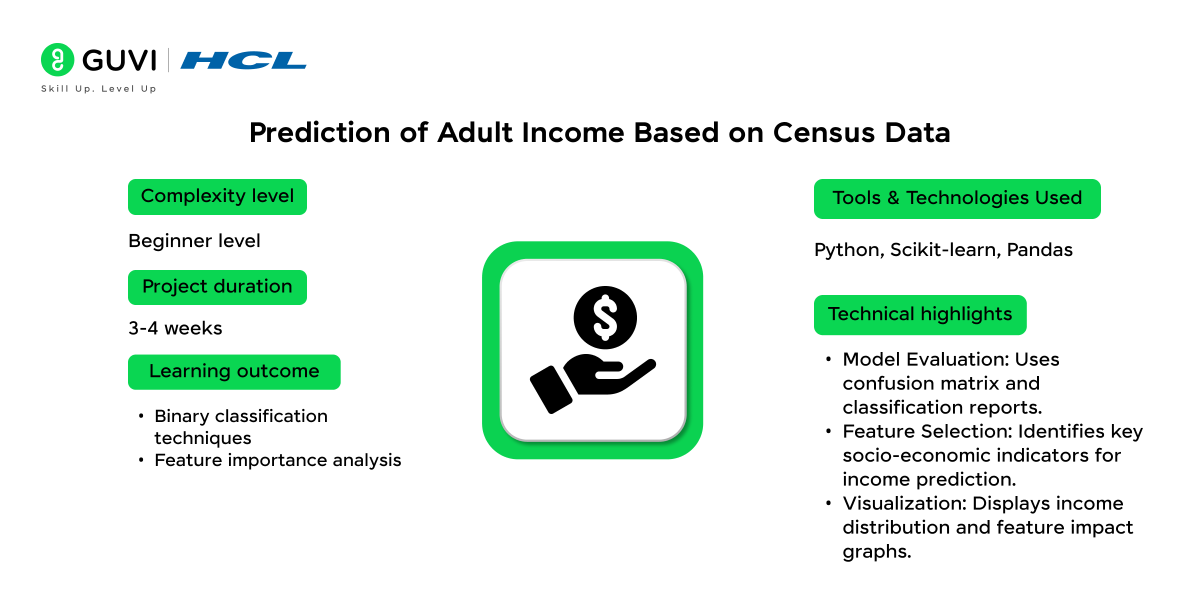
- Complexity Level: Beginner
- Technology Stack: Python, Scikit-learn, Pandas
- Project Duration: 3-4 weeks
- Learning Outcomes:
- Binary classification techniques
- Feature importance analysis
- Integration with APIs: Public census datasets
- Technical Highlights:
- Model Evaluation: Uses confusion matrix and classification reports.
- Feature Selection: Identifies key socio-economic indicators for income prediction.
- Visualization: Displays income distribution and feature impact graphs.
- Deployment Options: Local or web-based dashboard
- Source Code: [Link]
Final Words
By working on these data mining project topics, you not only enhance your analytical and programming skills but also gain hands-on experience with real-world datasets. Each project is designed to provide a unique learning curve, ensuring a robust understanding of data mining projects with source code.
I hope this list of the top data mining projects has been helpful in your learning journey and you have started building an array of interesting projects. If you have any doubts, reach out to us in the comments section below.
FAQs
Beginner-friendly Data Mining project ideas include customer segmentation, movie recommendation systems, credit card fraud detection, and sales trend analysis.
They help beginners understand data patterns, improve problem-solving skills, and gain hands-on experience in handling real-world datasets.
Key skills include data preprocessing, feature selection, model evaluation, and proficiency in tools like Python, R, or SQL.
A simple project like analyzing stock market trends using Excel or Google Sheets is ideal for those without programming experience.
Most beginner-level Data Mining projects can be completed within 1-2 weeks, depending on the complexity and the learner’s pace.





















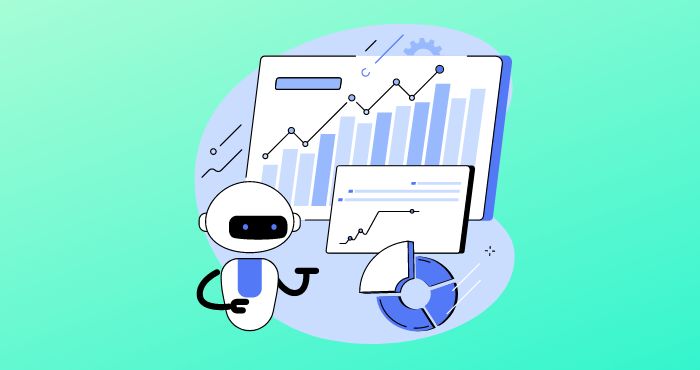

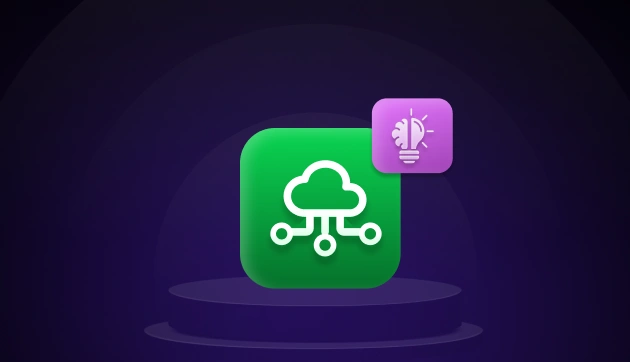
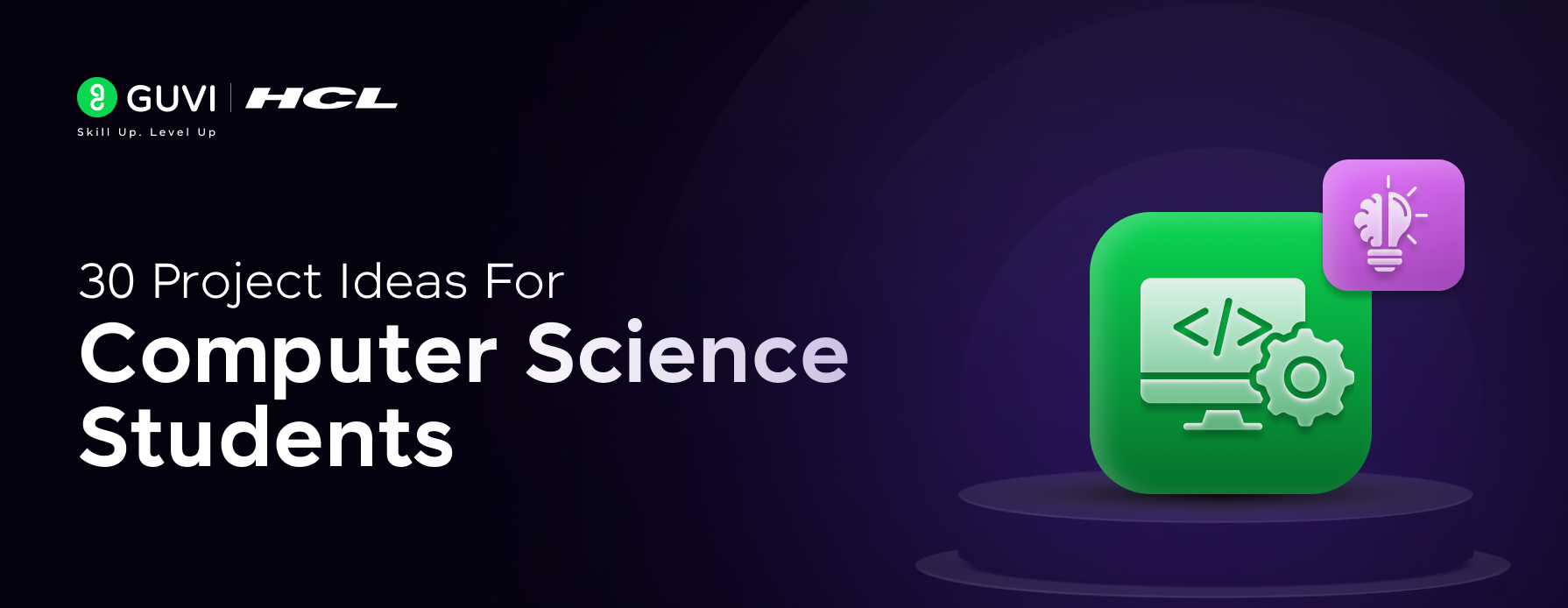
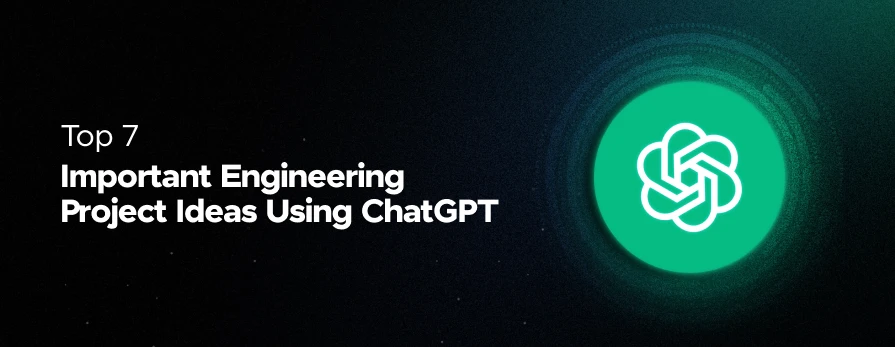
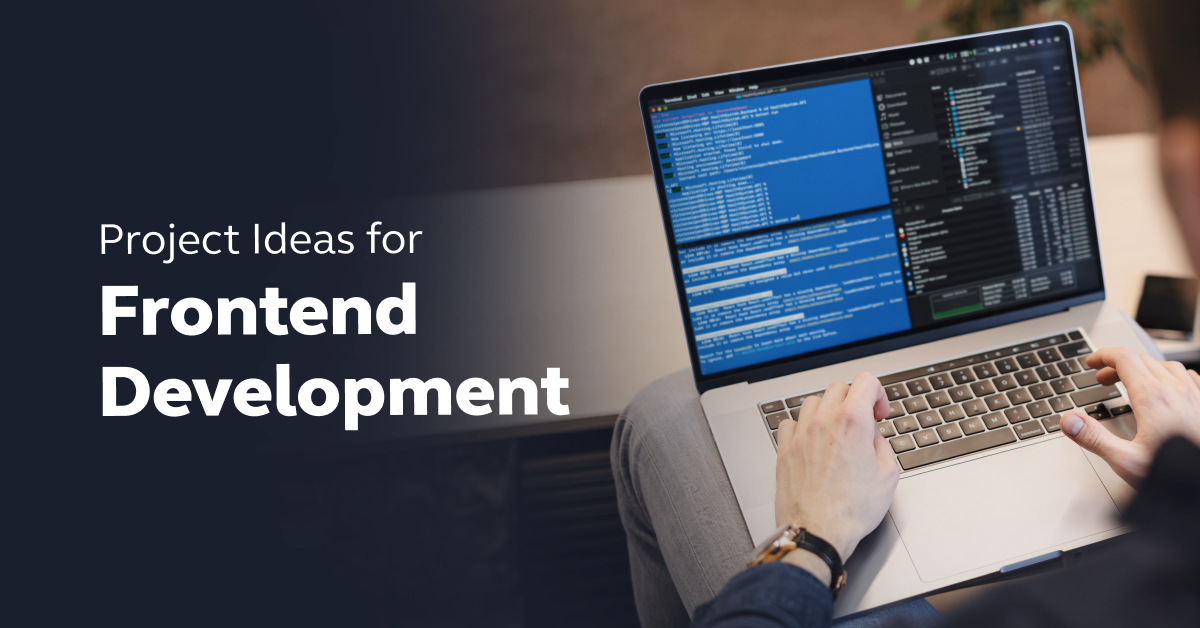

![Project-Based Learning: Smart Ideas and Important Tips To Implement It [2025] 25 Feature Image - Project-Based Learning](https://www.guvi.in/blog/wp-content/uploads/2024/05/feature_image.webp)
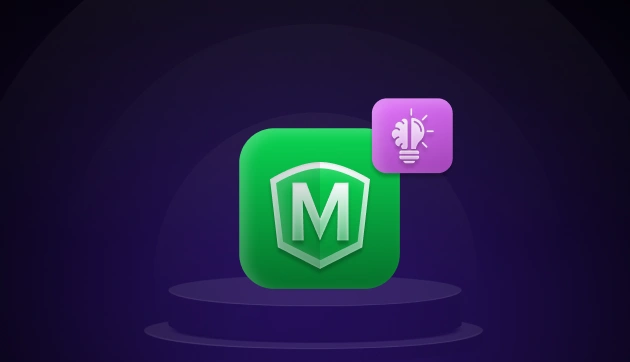

Did you enjoy this article?